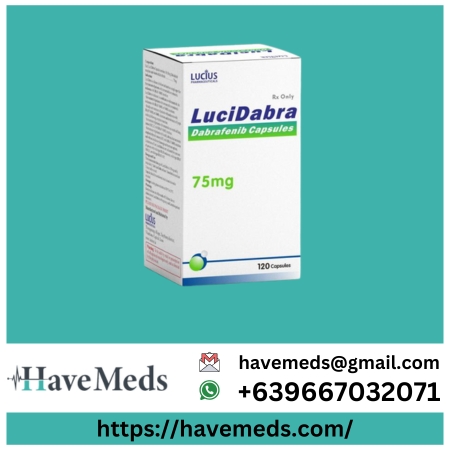
Product ID: 9959192
Reminder: Please follow the doctor’s advice when taking medicines. The mall only guarantees the quality of the medicines and does not provide medical advice
Lucidabra Dabrafenib capsules 75 mg
Authenticity guarantee
Direct Mail
Privacy packaging
Pharmacy Direct
This is a targeted oral therapy for the treatment of cancers with a specific mutation. BRAF V600E It is typically in combination with Trametinib for metastatic or advanced melanoma and, not rarely, NSCLC (non-small-cell lung cancer). It is a therapeutic option suitable for those patients who need molecularly targeted treatment adapted to the identified driver mutations of their cancer.
Pralsetinib. The capsules might be used mainly in RET-variant cancers, such as in the case of pralsetinib colorectal cancer or pralsetinib thyroid cancer, but dabrafenib is for BRAF mutant tumours, a confirmation of the complementary strategy in precision oncology.
Lucidabra Dabrafenib is a selective inhibitor of the mutant kinase BRAF V600E and a key component in the MAPK/ERK signalling cascade. The pathway controls cell division and survival; BRAF mutations drive rampant tumour growth by deregulating this pathway.
Although pralsetinib targets RET mutations, the specific therapy for patients with BRAF mutations is confirmed on dabrafenib. It is one of the drugs used in personalised treatment with MEK inhibitors like Tra
Metinib on the condition that the other part of the plan focuses on a vital step in combination therapies for Dabrafenib. It has as much relevance for the current targeted therapies that are being developed and springboarded by pralsetinib synthesis-based platforms on the horizon.
Dabrafenib is indicated for:
Unresectable or metastatic melanoma with BRAF V600E mutation
Metastatic NSCLC with BRAF V600E mutation
Anaplastic thyroid cancer with BRAF mutation
Trametinib with adjuvant therapy for resected melanoma
Like pralsetinib, thyroid cancer treatment taps right into RET mutations. Dabrafenib works for thyroid cancer of BRAF-positive types, stressing the need for genetic testing prior to commencing therapy.
Precision Targeting: Specifically inhibits BRAF V600E, reducing tumour growth
Combination Potential: Often used with Trametinib for increased efficacy
Convenient Oral Administration: Capsule form enables easy, at-home treatment
Rapid Tumour Response: Clinical trials show reduced tumour size and improved progression-free survival
Complementary Use: Can be integrated into regimens involving agents like pralsetinib capsules for multi-pathway treatment strategies
If pralsetinib's mechanism of action is RET fusion protein targeted, dabrafenib solves an important problem for BRAF-driven cancers.
Common side effects of Dabrafenib include:
Some of these side effects can overlap with pralsetinib side effects, so monitoring and medical advice are needed while on medication.
BRAF V600E kinase inhibitor. This inhibition prevents the activation of the MAPK/ERK signalling pathway, integral to promoting cell division and survival, that drives cancer. The reduction in the proliferative capacity of tumour cells and induction of apoptosis in cancer cells may be related to the inhibition of dabrafenib.
Like pralsetinib lung cancer mechanism of action will block RET kinases in pralsetinib. Dabrafenib is essential to the new pan-developed molecularly targeted spectrum of ours, which suppresses BRAF activity as well.
Dabrafenib dosing protocol is consistent with personalised therapy strategies as utilised by the pralsetinib manufacturer products.
Like with pralsetinib price and prescription hesitations, ask your oncologist first before starting the treatment.